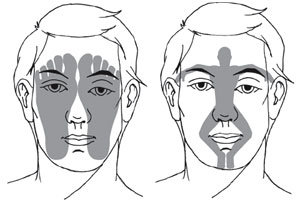There are systems of facial reflexology that use the acupressure points to bring about healing and balance elsewhere in the body. In facelift massage work, we try to focus on the Chinese facial rejuvenation acupressure points.
There is a system of facial reflexology that mimic foot reflexology by projecting the soles of the feet onto the face. In this instance, each foot is superimposed over the face with the heels at the chin area and toes extending above the eyebrows. Each foot lies to the side of the nose with the big toes touching in the mid-forehead. In a similar projection, the whole body can be superimposed over the face. In this case, the torso resides over the bridge of the nose with the buttocks at the end of the nose. The head is in the center of the forehead. The arms warp over and around the eyes with the hands at the outside corners of the eyes. The legs surround the mouth with the knees at the corner and the feet coming together at the base of the chin. This system also allows you to visualize and work various body joints on the face.
Designing a plan for using this information in a practical format can be challenging, given that there are so many systems available.

One easy “how-to” plan is to mimic foot reflexology on the face. This system is the easiest to grasp and use effectively as it reflects a common hands-on modality that is familiar to many healers. Using the visual of the soles of the feet superimposed over the face, follow the flow as you would for a traditional reflexology session. Typically this starts at the toes and works down the feet. So start at the forehead and work your way down the face (body) ending at the chin and jaw line. This will provide a healing and relaxing session that clients love. Because the face often holds stagnant
qi and lymph, prewarm the tissue surrounding the lymphatic terminus (near the hollow at the base of the throat), the anterior and lateral neck muscles and the submandibular region. This need only be a minute or two, but will provide the necessary circulation to properly drain the face of stagnation.
As a general rule, working from top to bottom relaxes, and working from bottom to top activates. I like to relax first then, if the client is getting up soon, finish with a few bottom to top strokes to energize them. Along this same thought, a short activation of a point (four to five seconds) typically excites the system while a longer one (45 seconds to several minutes) tones or relaxes the system. Although you are working lightly on the face, the client may still experience some discomfort if a point is sensitive. In this case, intermittent pressure can help calm the point. Some suggest a slight circular movement in a clockwise direction for points. Some suggest only to lightly massage the point. Treat each point or area with a deliberate stroke but seam them together as a single movement.
The face and scalp are easy targets for us to get to and offer a plethora of benefits to your clients. And it makes for easy work on the therapist.
Rita Woods is the owner of Unique Natural Skin Care, and a trainer and workshop facilitator on issues of spiritual growth and wellness. She may be contacted at www.uniqueskincare.com.




